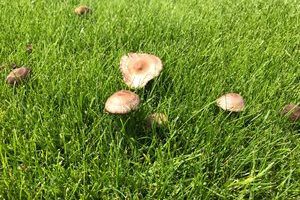 First things first, toadstools or mushrooms as they’re also sometimes referred to, are usually a good sign that a lawn is healthy; they are only temporary and not something to be too concerned about.
First things first, toadstools or mushrooms as they’re also sometimes referred to, are usually a good sign that a lawn is healthy; they are only temporary and not something to be too concerned about.
Toadstools found in lawns are generally fairly small and brown in colour and will occur in most lawns at some point when the conditions are ideal for them, such as when it’s warm and humid.
Why do toadstools occur when turf has just been laid?
It’s very common for toadstools to make an appearance in new turf because each roll of turf contains thousands of fungi – all very normal and natural – though only a few of these fungi will form toadstools. The reason they sometimes occur in newly laid turf is that the fungi are stimulated by the harvesting process, then the new lawn care process, which involves plenty of watering, provides a nice, moist environment for the toadstools to grow.
Are toadstools poisonous to children or pets?
Without seeing them or having formal identification, it’s difficult to say whether the specific toadstools in a lawn are poisonous or not. The type of toadstools that commonly occur in a garden lawn are not toxic. However, we wouldn’t recommend eating them as they could be harmful if eaten in large quantities or if allergies occur; the same can be said for many plants found in the garden. As a precaution, we would recommend that children and pets are kept away from any unidentified toadstools until they have been removed.
If left, the toadstools will usually disappear within a few weeks, or when there is a change in weather and are unlikely to reoccur unless they are growing from plant debris under the turf; more about this below.
How to manage toadstools in a lawn
Toadstools can be removed by mowing, brushing or picking by hand. If you do pick them you should wear gloves as a precaution and always dispose of them immediately.
There aren’t currently any fungicides to treat toadstools, so don’t be tempted to treat the lawn to remove them; fungi in a lawn is essential to its long-term health and necessary to maintain an attractive lawn.
As mentioned earlier, sometimes the toadstools are growing up from underneath the lawn rather than in the lawn itself. You can check this by digging underneath the site of toadstools to see whether it is plant debris under the lawn that they are growing from. A sharp knife is ideal for digging a small area to avoid too much damage.
If you do find plant debris under the lawn and want to prevent toadstools from reappearing, you may want to consider digging the debris out, though this will usually involve having to replace the turf or reseed the area. Bear in mind that the fungi spores can be easily spread and are often brought into the garden by wildlife or pets from areas they’ve been walking, so they can be difficult to remove permanently.
Will they affect the long-term health of the lawn?
Not at all. If a lawn is new and the advice above is followed, it’s unlikely that there will be a recurrence. In an established lawn, consider removing some of the thatch (build-up of dead grass, moss and weeds) and reducing the amount of fertiliser used until they have cleared, but it’s highly unlikely that they will degrade the health of the lawn; rest assured, they are a natural element of having a lawn.
Our article ‘How to scarify a lawn’ gives further advice on removing thatch.
We hope you have found this article interesting. If so, please feel free to share on Facebook, Twitter and Pinterest. If you would like to stay up-to date with our news, advice and special offers, why not sign up to our newsletter.